
The distribution of fixed costs to total costs decreases proportionately with the number of units produced, so extra care must be taken. Begin by entering the starting number of units produced and the total cost, then enter the future number of units produced and their total cost. It’s inevitable that the volume of output will increase or decrease with varying levels of production. The quantities involved are usually significant enough to evaluate changes in cost. An increase or decrease in the volume of goods produced translates to costs of goods manufactured (COGM).
- Incremental costs are also used in the management decision to make or buy a product.
- However, you should also consider other factors such as revenue potential and risk when making your decision.
- The reason for the relatively small incremental cost per unit is due to the cost behavior of certain costs.
- Below are the current production levels as well as the added costs of the additional units.
- Conversely, fixed costs, such as rent and overhead, are omitted from incremental cost analysis because these costs typically don’t change with production volumes.
- Incremental cost, also referred to as marginal cost, is the total change a company experiences within its balance sheet or income statement due to the production and sale of an additional unit of product.
Incremental Cost Decisions
Incremental costs are relevant in making short-term decisions or choosing between two alternatives, such as whether to accept a special order. If a reduced price is established for a special order, then it’s critical that the revenue received from the special order at least covers the incremental costs. Professionals working in a wide range of corporate finance roles calculate the incremental cost of production as part of routine financial analysis.
- The usual variable costs included in the calculation are labor and materials, plus the estimated increases in fixed costs (if any), such as administration, overhead, and selling expenses.
- Imagine that you are the owner of a small business that manufactures and sells widgets.
- The attempt to calculate and accurately predict such costs assist a company in making future investment decisions that can increase revenue and reduce costs.
- Alternatively, once incremental costs exceed incremental revenue for a unit, the company takes a loss for each item produced.
- If oil prices are expected to decline, then the long run incremental cost of producing the good is also likely to decline.
- Fixed costs are those that do not change with production or sales, such as rent and insurance.
Supercharge your skills with Premium Templates

My Accounting Course is a world-class educational resource developed by experts to simplify accounting, finance, & investment analysis topics, so students and professionals can learn and propel their careers. When making a decision, you should compare the ICC of the options to see which one is most cost-effective. However, you should also consider other factors such as revenue potential incremental cost and risk when making your decision. Imagine that you are the owner of a small business that manufactures and sells widgets. You are considering expanding your business by opening a second factory. Get instant access to lessons taught by experienced private equity pros and bulge bracket investment bankers including financial statement modeling, DCF, M&A, LBO, Comps and Excel Modeling.
Uses for Incremental Analysis
Also called marginal analysis, the relevant cost approach, or differential analysis, incremental analysis disregards any sunk cost (past cost). This nuanced understanding and its relationship to both variable and fixed costs is critical for making effective decisions in the dynamic realm of production expansion and pricing strategies. Since the fixed cost is being incurred regardless of the proposed sale, it is classified as a sunk cost and ignored. The company should accept the order since it will earn $1 ($12-$11) per unit sold, or $1,000 in total.
Incremental cost analysis is often used to analyze business segments to determine their profitability. All fixed costs, such as rent, are omitted from incremental cost analysis because they do not change and are generally not specifically attributable to any one business segment. Alternatively, once incremental costs exceed incremental revenue for a unit, the company takes a loss for each item produced. Therefore, knowing the incremental cost of additional units of production and comparing it to the selling price of these goods assists in meeting profit goals. Certain costs will be incurred whether there is an increase in production or not, which are not computed when determining incremental cost, and they include fixed costs. However, care must be exercised as allocation of fixed costs to total cost decreases as additional units are produced.
- It also takes into account sunk, or non-relevant costs, and excludes those from analysis.
- When making a decision, you should compare the ICC of the options to see which one is most cost-effective.
- A sunk cost is a cost that has already been incurred and cannot be recovered.
- Conversely, marginal costs refer to the cost of producing one more unit of a service or product.
- Understanding the additional costs of increasing production of a good is helpful when determining the retail price of the product.
- ICC can help you optimize your resources and make the most of your investment opportunities.
Long Run Incremental Cost (LRIC) vs. Marginal Cost
The management must look at the additional cost of producing the products under one roof. This could mean more deliveries from vendors or even https://www.bookstime.com/ more training costs for employees. However, when a company’s factory is at full capacity, creating an extra unit goes beyond variable costs.
Free Accounting Courses
For example, in the case of a restaurant that is only allowed to seat twenty-five people due to local regulations, increasing capacity by just one person may necessitate incurring construction costs. Take your learning and productivity to the next level with our Premium Templates. Access and download collection of free Templates to help power your productivity and performance. Shaun Conrad is a Certified Public Accountant and CPA exam expert with a passion for teaching. After almost a decade of experience in public accounting, he created MyAccountingCourse.com to help people learn accounting & finance, pass the CPA exam, and start their career. Striking the right balance between overproduction and underproduction ensures efficient resource utilization.

Incremental Analysis

An important component of incremental analysis, a framework for decision-making used by managers, entrepreneurs, and investors, is incremental cost. The company can evaluate the financial effects of increasing production and decide whether increasing output will be profitable. It’s important to remember that some expenses, especially fixed costs, don’t change whether production rises or falls. In the sections below, you’ll find out what you need for proper ICC calculation. Be sure to read until the end for answers to frequently asked questions.
Incremental Revenue vs. Incremental Cost
Johnson Tires, a public company, consistently manufactures 10,000 units of truck tires each year, incurring production costs of $5 million. Before calculating ICC, you need to determine the fixed costs and the variable costs. Fixed costs are those that do not change with production or sales, such as rent and insurance.
